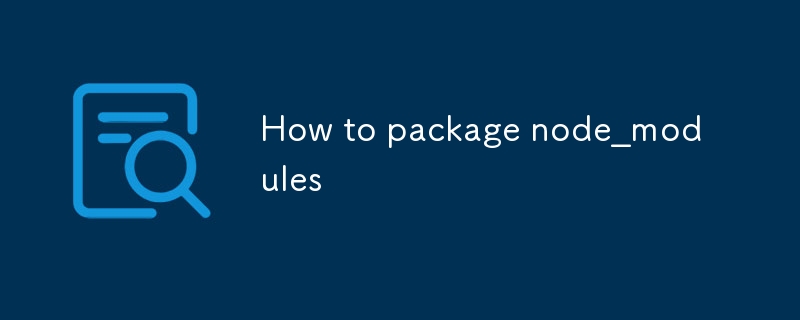node_modules 怎么打包
- DDD原创
- 2024-08-14 16:29:18781浏览
本文探讨了部署过程中node_modules的有效打包策略。它通过树摇动、缩小和缓存等最佳实践解决了优化包大小的问题。此外,它还讨论了

如何有效地打包我的node_modules以进行部署?
要有效地打包你的node_modules以进行部署,请考虑以下方法:node_modules for deployment, consider the following approaches:
- Tree shaking: Remove unused code from your modules using tools like Rollup or Webpack.
- Minification: Reduce file sizes by removing unnecessary characters and formatting.
- Vendor Prefixes: Identify and separate commonly used dependencies into a separate "vendor" bundle.
- Caching: Implement caching mechanisms to avoid repeated downloads of dependencies.
- Containerize: Use containerization tools like Docker or Kubernetes to package your application and its dependencies as a single unit.
What are the best practices for optimizing node_modules bundle size?
To optimize the bundle size of your node_modules, follow these best practices:
- Use a bundler: Employ tools like Webpack or Rollup to bundle your dependencies, which can reduce file size and improve load times.
- Choose small dependencies: Opt for lightweight dependencies that align with your application's specific needs.
- Use scope hoisting: Hoist shared dependencies into a parent bundle to avoid duplication.
- Use devDependencies selectively: Include only the necessary devDependencies and exclude them from the production bundle.
- Consider code splitting: Divide your application into smaller chunks to reduce the initial bundle size and improve performance.
How to handle dependencies and 版本之间的冲突时打包 node_modules?
To handle dependency and version conflicts while packaging node_modules, follow these strategies:
-
Use lock files: Implement lock files like
package-lock.jsonoryarn.lock - Tree shakes: 使用 Rollup 或 Webpack 等工具从模块中删除未使用的代码。
- 缩小: 通过删除不必要的字符和格式来减小文件大小。
- 供应商前缀: 识别常用的依赖项并将其分离到单独的“
- 缓存: 实施缓存机制以避免重复下载依赖项。
node_modules 的捆绑包大小,请遵循以下最佳实践:🎜- 🎜🎜使用捆绑器:🎜 使用 Webpack 或 Rollup 等工具捆绑您的依赖项,这可以减少文件大小并缩短加载时间。🎜🎜🎜选择小型依赖项:🎜选择符合应用程序特定需求的轻量级依赖项。🎜🎜🎜使用范围提升:🎜将共享依赖项提升到父包中避免重复。🎜🎜🎜有选择地使用 devDependency:🎜 仅包含必要的 devDependency 并将它们从生产包中排除。🎜🎜🎜考虑代码拆分:🎜 将应用程序划分为更小的块,以减少初始包大小并提高性能。🎜🎜 🎜如何处理node_modules之间的依赖和版本冲突时的资源?🎜🎜要在打包
node_modules时处理依赖和版本冲突,请遵循以下策略:🎜- 🎜🎜使用锁文件:🎜实施锁定
package-lock.json 或 yarn.lock 等文件,以确保整个团队和环境中的依赖项版本一致。🎜🎜🎜使用依赖项管理器:🎜 使用 npm 等依赖项管理器或者yarn,它可以管理依赖解析、冲突处理和版本更新。🎜🎜🎜使用语义版本控制:🎜遵循语义版本控制原则来传达版本冲突并指示依赖更新的潜在影响。🎜🎜🎜考虑monorepos:🎜使用monorepos如果您有多个相关项目要集中管理共享依赖项。🎜🎜🎜与跨职能团队沟通:🎜与负责测试、部署和运营的团队协调,确保依赖项跨环境兼容。🎜🎜以上是node_modules 怎么打包的详细内容。更多信息请关注PHP中文网其他相关文章!
声明:
本文内容由网友自发贡献,版权归原作者所有,本站不承担相应法律责任。如您发现有涉嫌抄袭侵权的内容,请联系admin@php.cn
上一篇:如何在前端展示公式下一篇:el-tree 只在父节点前面加icon

